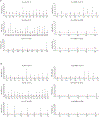Association between Human Leukocyte Antigen Type and Keratinocyte Carcinoma Risk in Renal Transplant Recipients
- PMID: 31669059
- PMCID: PMC7720817
- DOI: 10.1016/j.jid.2019.09.016
Association between Human Leukocyte Antigen Type and Keratinocyte Carcinoma Risk in Renal Transplant Recipients
Abstract
Keratinocyte carcinoma (KC), defined as squamous cell carcinoma and basal cell carcinoma, is the most common malignancy among white, non-Hispanic renal transplant recipients. Although recent genome-wide association studies reported that class II HLA is associated with KC risk, epidemiologic data on HLA type and KC risk in renal transplant recipients is limited. Using an institutional cohort of white, non-Hispanic renal transplant recipients transplanted between 1993 and 2017, we examined the association between pretransplant molecular HLA types and KC risk. Posttransplant KCs were captured using the International Classification of Diseases codes and validated using pathology reports. Cox proportional hazards regression models were used to estimate hazard ratios of incident KC, squamous cell carcinoma, and basal cell carcinoma, adjusting for age, male sex, history of KC, Charlson comorbidity index, HLA mismatch, transplant type, year of transplant, and the type of immunosuppression. Among 617 subjects (mean age 53 years, 67% male), 10% developed posttransplant KC. Multivariable Cox regression analyses showed HLA-DRB1∗13 was associated with KC risk (hazard ratio, 1.84; 95% confidence interval, 1.00-3.38) and squamous cell carcinoma risk (hazard ratio, 2.24; 95% confidence interval, 1.12-4.49), whereas HLA-DRB1∗14 (hazard ratio, 2.81; 95% confidence interval, 1.14-6.91) was associated with basal cell carcinoma risk. Our findings suggest that a subset of renal transplant recipients with specific HLA polymorphisms may be at increased KC risk.
Copyright © 2019 The Authors. Published by Elsevier Inc. All rights reserved.
Conflict of interest statement
CONFLICT OF INTEREST
Dr. Asgari has received institutional grant funding from Pfizer Inc. for unrelated research (involving atopic dermatitis). The remaining authors have to conflict of interest to disclose.
Figures



Similar articles
-
The presence of betapapillomavirus antibodies around transplantation predicts the development of keratinocyte carcinoma in organ transplant recipients: a cohort study.J Invest Dermatol. 2015 May;135(5):1275-1282. doi: 10.1038/jid.2014.456. Epub 2014 Oct 27. J Invest Dermatol. 2015. PMID: 25347116
-
Association between Use of Hydrochlorothiazide and Risk of Keratinocyte Cancers in Kidney Transplant Recipients.Clin J Am Soc Nephrol. 2020 Dec 7;15(12):1804-1813. doi: 10.2215/CJN.02560220. Epub 2020 Nov 10. Clin J Am Soc Nephrol. 2020. PMID: 33172936 Free PMC article.
-
Nicotinamide for secondary keratinocyte carcinoma prevention in solid organ transplant recipients.Arch Dermatol Res. 2025 Jun 11;317(1):807. doi: 10.1007/s00403-025-04296-7. Arch Dermatol Res. 2025. PMID: 40498148
-
Epidemiology of keratinocyte carcinomas after organ transplantation.Br J Dermatol. 2017 Nov;177(5):1208-1216. doi: 10.1111/bjd.15931. Epub 2017 Oct 10. Br J Dermatol. 2017. PMID: 28994104 Review.
-
Keratinocyte Carcinoma as a Marker of a High Cancer-Risk Phenotype.Adv Cancer Res. 2016;130:257-91. doi: 10.1016/bs.acr.2016.01.003. Epub 2016 Feb 23. Adv Cancer Res. 2016. PMID: 27037755 Review.
Cited by
-
Cutaneous Squamous Cell Carcinoma Arising in Immunosuppressed Patients: A Systematic Review of Tumor Profiling Studies.JID Innov. 2022 Mar 30;2(4):100126. doi: 10.1016/j.xjidi.2022.100126. eCollection 2022 Jul. JID Innov. 2022. PMID: 35620703 Free PMC article. Review.
-
Molecular Alterations in Cutaneous Squamous Cell Carcinoma in Immunocompetent and Immunosuppressed Hosts-A Systematic Review.Cancers (Basel). 2023 Mar 17;15(6):1832. doi: 10.3390/cancers15061832. Cancers (Basel). 2023. PMID: 36980718 Free PMC article. Review.
-
Human leukocyte antigen type does not improve risk stratification for SUNTRAC score in solid organ transplant recipients: A cohort study.JAAD Int. 2024 Aug 31;17:80-81. doi: 10.1016/j.jdin.2024.07.026. eCollection 2024 Dec. JAAD Int. 2024. PMID: 39411238 Free PMC article. No abstract available.
References
-
- Aureli A, Canossi A, Del Beato T, Franceschilli L, Buonomo O, Papola F, et al. HLA-DRB1*13:01 allele in the genetic susceptibility to colorectal carcinoma. Int J Cancer 2015;136:2464–8. - PubMed
-
- Barrett WL, First MR, Aron BS, Penn I. Clinical course of malignancies in renal transplant recipients. Cancer 1993;72:2186–9. - PubMed
Publication types
MeSH terms
Substances
Grants and funding
LinkOut - more resources
Full Text Sources
Medical
Research Materials

